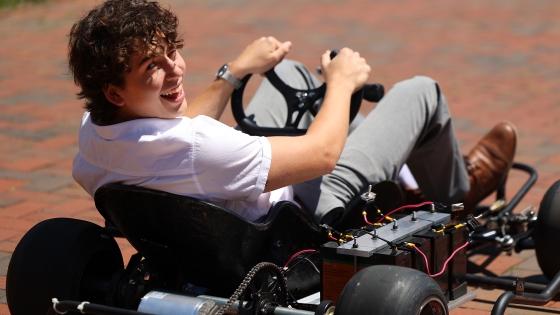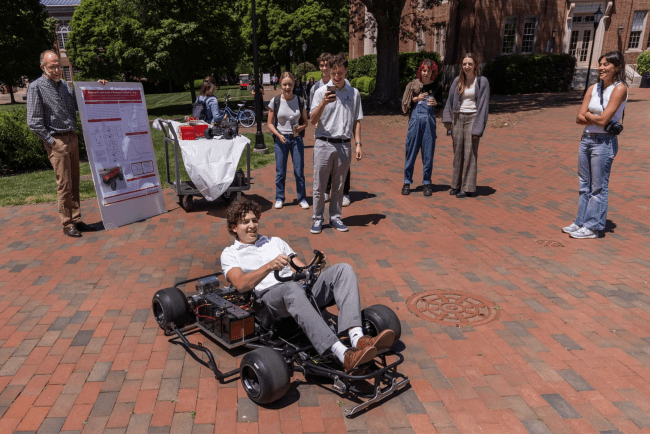My Davidson | A Student Blog Engineering at a Liberal Arts College: Davidson Students Build Hydrogen-Powered Go-Kart

Physics students Mallory Justis ’24, Branner D'Amato ’24 and Pat Kielb ’24 reflect on their process designing and building a hydrogen-powered go-kart and the ways you can pursue engineering interests at Davidson College.
About the Authors
Mallory Justis ’24 (she/her), Branner D’Amato ’24 (he/him) and Pat Kielb ’24 (he/him) are physics majors from North Carolina, West Virginia and Washington, D.C. (respectively).
What happens when you give three physics majors $5,000 dollars, a big laboratory in the physics building and tell them to build a go-kart?
The whole thing started at the spring 2022 annual physics picnic with a discussion about how cool it would be to build a car. And then we thought, why not actually do it? Keith Frye, who runs the physics machine shop, loves racing and races some of his own sprint cars. And Dr. John Yukich really enjoys building things. So we thought, might as well give it a try, right?
We decided to go for a hydrogen powered go-kart. Once we got Dr. Yukich and Keith on board, Branner went to work securing us money from the college (Mallory still doesn’t know where any of it came from or how we got it but that’s the point of group projects, right?). We were all abroad in the fall semester, so it was difficult to get it together, but we somehow managed to do it. Pat ordered the fuel cell, and Mallory responded “Great!” to all the emails. When the spring 2023 semester started, we began working.
The basic idea was to build an electric go-kart, but instead of charging the batteries with a wall outlet, the hydrogen fuel cell would provide the power to charge the batteries. We were fortunate to have a go-kart body donated, and we started our semester with a lot of research. Each week, one of us also researched a new topic (if you ever need super specific information on batteries, talk to Mallory, or if you’re into hydrogen trains, talk to Branner). We assembled the fuel cell, and began testing.
We had a giant tank of hydrogen in our lab, which definitely caused some uneasiness in the physics department. But we kept the windows open and had a gas detector in the lab, and we didn’t end up blowing up the physics building, which was definitely a key to our success.
The biggest setback in the project was that the fuel cell (which supplied 19 volts) only supplied 0.5 amps. We knew the voltage when we bought it, but we didn’t know what the current would be. What that means for all you humanities majors is that it would take about two weeks to fully charge the batteries if we charged them with the fuel cell. If we wanted a hydrogen fuel cell that would supply enough current, we would probably have had to all sell our cars and the combined total proceeds might possibly have gotten us a fuel cell with enough current.
Despite our disappointment, we ended up making the final project in two parts. We created a miniature RC kart, which had a battery charged from the fuel cell, and we had a full size go-kart powered by the batteries. Mallory created a safe charging system for the large go-kart batteries that plugged into the wall. If we had a bigger fuel cell, we’d simply connect the safe charging system to the fuel cell’s DC current, rather than plug it into the wall. We were still able to create everything we wanted, just in a different set up.
We don’t mean to brag, but the go-kart was definitely the biggest hit at the Verna Miller Case Symposium. Even some physics professors drove it around! We are all very grateful for the opportunity to explore something that interested us, and we’re excited to have brought an engineering project to Davidson.

Verna Miller Case Symposium, Spring 2023
Gaining engineering experience while at a liberal arts school is a unique experience, and we are so happy that Dr. Yukich was excited about letting us explore something we’re interested in. We want to encourage anyone at Davidson who has a cool idea to try it. Tell a professor about it. We didn’t have help from an engineering expert, and we ended up Googling a lot of things and causing quite a few sparks trying to wire things, but figuring it out on our own was what made the project so valuable and interesting.
We worked well together as a team, too. We’d all had classes together and been friends since our first year, but the project really brought us together. Branner and Mallory both work in the Makerspace, and we were also all taking “Electricity and Magnetism” together this semester, so we ended up spending just about every day together. We even got a boat from the Davidson sailing team and started sailing at Lake Campus on Thursday afternoons after working in our lab.
What’s next for the Hydro-Kart team? This summer, Branner and Pat are creating new isotopes using a particle accelerator with Dr. Anthony Kuchera in Florida and Mallory is designing a mission to Mars in Australia. Next year, we’re rebranding ourselves as the Tiny House Team, as we plan to spend our senior year building a tiny house. Stay tuned…